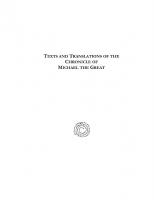Two Sanskrit Inscriptions Engraven on Stone: The Original Texts, with Translations and Comments 9781463225223
A significant portion of this article contains the original texts, translations, and comments of two Sanskrit inscriptio
228 84 4MB
English Pages 43 Year 2010
Recommend Papers

- Author / Uploaded
- Fitzedward Hall
File loading please wait...
Citation preview
Two Sanskrit Inscriptions Engraven on Stone
So"hi iV s f t f Y ^ i m Jk -< %>
—«»
Analecta Gorgiana
520 Series Editor George Anton Kiraz
Analecta Gorgiana is a collection of long essays and short monographs which are consistently cited by modern scholars but previously difficult to find because of their original appearance in obscure publications. Carefully selected by a team of scholars based on their relevance to modern scholarship, these essays can now be fully utilized by scholars and proudly owned by libraries.
Two Sanskrit Inscriptions Engraven on Stone
The Original Texts, with Translations and Comments
Fitz-Edward Hall
1 gorgias press 2010
Gorgias Press LLC, 180 Centennial Ave., Piscataway, NJ, 08854, USA www.gorgiaspress.com Copyright © 2010 by Gorgias Press LLC Originally published in All rights reserved under International and Pan-American Copyright Conventions. No part of this publication may be reproduced, stored in a retrieval system or transmitted in any form or by any means, electronic, mechanical, photocopying, recording, scanning or otherwise without the prior written permission of Gorgias Press LLC. 2010 ' ^
1 ISBN 978-1-61719-035-3
ISSN 1935-6854
Extract from Journal of the American Oriental Society 6 (1858-1860)
Printed in the United States of America
ARTICLE
TWO S A N S K R I T ENGRAVEN
THE W I T H
IV.
INSCRIPTIONS ON
ORIGINAL
T R A N S L A T I O N S BY F I T Z - E D W A R D
STONE :
TEXTS, A N D
HALL,
C O M M E N T S .
E S Q . , M. A.
Presented to the Society October 26, 1859.
THE stones containing the inscriptions now published were procured, the first at Bhera Ghat a on the Nerbudda, and the other at the village of Tewar.b Both these places I visited, in 1857, while on the first march from Jubulpoor to Nursinghpoor. The larger stone had been brought, as serviceable buildingmaterial, to the side of a temple which was in course of erection. When rescued, it was on the point of being buried, face downward, in one of the walls. Had its threatened fate been realized, quite possibly it would not have been spoken of in print for several centuries. More than one historical fact deserving of record has been discovered from these monuments. The queen of Gayakarna Deva, Alhana Devi, was daughter of a Rana of Udeypoor, and granddaughter, through her mother, of Udayaditya, c king of Malwa. The paternal greatgrandfather of this lady, flansapala, is, further, a representative of the royal house of Mewar, now first -brought to light. A near approximation to the dates of three of her progenitors being practicable, a basis is afforded by which a portion of the current chronology, for the mediasval period, of preeminently the foremost family of Rajpoots may be readjusted to advantage. The names of the modern rulers of Chedi,d beginning with the earliest, and the names of their consorts and kinsmen, so far
500
F. E. Hall,
as they have been ascertained, shall here be exhibited. The first genealogical table shows the family that reigned in Central India: Lakshmana Deva e or Yuvar&ja Deva. f Kokalla Deva. G&ngeya Deva. Kama Deva.® He married A'valia Devi, a H\ina.h Yas'ahkarna Deva.' Gayakarna Deva.J He married Alhana Devi. k Narasinha Deva. 1 Jayasinha Deva, brother of the last. Vijayasinha. He married Gasala Devi. Ajayasinha Deva, m heir apparent.
Alhana Devi's ancestry, as deduced from my larger inscription, was as follows: Hansapala, a Gobhila." Vairisinha. Vijayasinha. 0 He married S'yamala Devi, daughter of TTday&ditva of Malava; and these were the parents of Alhana Devi.
The second person mentioned in my larger inscription has a very unusual name. That his kingdom was that of Chedi is beyond doubt. I am not prepared to pronounce him identical with the Kokalla who is expressly said to have been lord of that country, and who was likewise a Haihaya; but as, on further enquiry, the two may turn out to be one, I shall enumerate such of the descendants of the latter as are known from inscriptions that have been found in the west: S'adruka.
S'ankaragana or Ranavigraha. Mah&lakshmi or Lakshmi, and Govindamba, were his daughters.
Mah&devi.
Arjuna. His son was Aggana (?) Deva, who had a daughter Dwij&mba.
This Kokalla thus had, at least, three sons and one daughter. S'adruka, after a single glimpse, is seen no more. S'ankaragana p is termed lord of Chedi: but it is questionable whether the title was ever more than a compliment of hopeful expectation. Mahadevi fnarried a royalet named Krishna. W h o he was we are still to learn. Their son, Jagadrudra or Jagattunga, as to whose nationality equally little has transpired, married his two cousins german, Lakshmi and Govindamba. This spirited polygamist had, however, already wedded a daughter of Akalavarsha; but he had by her, it should seem, no issue. Indra, his son by Lakshmi, was nevertheless allowed—so elastic is Hindu courtesy—to be a grandson of Akalavarsha, and was his heir to the
Two Sanskrit Inscriptions,
501
Yadava raja-ship. Indra's wife was Dwijamba, granddaughter of his grandparents' brother Arjuna.i Far from insignificant were the later dukes of Chedi,r as is patent from their matrimonial alliances: and yet—such is the caprice of fortune—the extent of their occupancy can now be estimated only by the opinion of their power; and the determination of its locality has not been effected without some little research. In the most recent of their inscriptions is the last word of them that oblivion has not usurped. Their neighbors, the kings of Gadhamandala, may have wrought their extinction; for, as it appears, their territory passed in part to those chieftains, while the eastern shire of it was ultimately possessed by the Baghelas of Rewa. The later Bhoja of Central India has been assigned, on tolerably cogent gounds, to the middle of the eleventh century. Of his grandsons, one, Lakshmidhara, was living in A. D. 1104; and another, Naravarman, died in 1133." Udayaditya, who connects the two generations, may, then, have flourished about 1075. Alhana Devi, who is named, in the older of my two inscriptions, as if she were still surviving at the time of its execution, was a granddaughter, 1 as we have seen, of Udayaditya. She may thus have been born about 1100. According to the sequel of this paper, and other evidence, one of her sons, Narasinha, was reigning in a year 907; another, Jayasinha, in 928; and her greatgrandson, Ajayasinha, was a minor in 932." Her birth may, therefore, have taken place as early as 850, which carries back Udayaditya perhaps to 790. These lesser numbers plainly do not denote either the era of S'alivahana or that of Vikramaditya. v Nor can they be computed from that of Valabhi, as ordinarily assumed to count from A. D. 319: a position which, in passing, I believe to be contestable. The specifications attached to the dates 907 and 928 are, however, so full, that any one who chooses to undertake a somewhat tedious calculation is provided with data from which the first year of this, or of some other unaccustomed epoch, may be definitely determined. Of the two inscriptions now edited, the second, a rude specimen of engraving, I copied with its stone before me. As for the first, I have made use of a couple of fac-simile tracings from it: but they were prepared by a native, a Muhammadan, who was unable to read a letter of the original, and who, consequently, is not to be suspected of conscious attempts at amendment. w The style and conformation of its characters resemble, as nearly as possible, those observed on the copperplate of Gasala Devi. At the end of the sixth, sixteenth, and thirty-first stanzas are elaborate flourishes. Once they were, it may be, of some significance, now forgotten: here they simply mark the conclusions of paragraphs. you vi.
64
F. U. Salit
502
íftHi
RH:
^PTTfWTFferTf HFT
fèt
tor
W r f
^crllHN^HI
^ r









